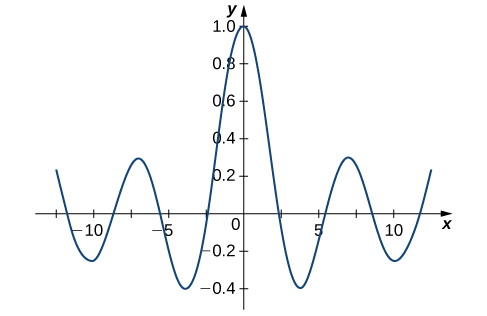Assume
(step 1). Then,
and
(step 2). We want to find values for the coefficients
such that
We want the indices on our sums to match so that we can express them using a single summation. That is, we want to rewrite the first summation so that it starts with
To re-index the first term, replace n with
inside the sum, and change the lower summation limit to
We get
This gives
Because power series expansions of functions are unique, this equation can be true only if the coefficients of each power of x are zero. So we have
This recurrence relationship allows us to express each coefficient
in terms of the coefficient two terms earlier. This yields one expression for even values of n and another expression for odd values of n. Looking first at the equations involving even values of n, we see that
Thus, in general, when n is even,
(step 5).
For the equations involving odd values of n, we see that
Therefore, in general, when n is odd,
(step 5 continued).
Putting this together, we have
Re-indexing the sums to account for the even and odd values of n separately, we obtain
Analysis for part a.
As expected for a second-order differential equation, this solution depends on two arbitrary constants. However, note that our differential equation is a constant-coefficient differential equation, yet the power series solution does not appear to have the familiar form (containing exponential functions) that we are used to seeing. Furthermore, since
is the general solution to this equation, we must be able to write any solution in this form, and it is not clear whether the power series solution we just found can, in fact, be written in that form.
Fortunately, after writing the power series representations of
and
and doing some algebra, we find that if we choose
we then have
and
and
So we have, in fact, found the same general solution. Note that this choice of
and
is not obvious. This is a case when we know what the answer should be, and have essentially “reverse-engineered” our choice of coefficients.
Assume
(step 1). Then,
and
(step 2). We want to find values for the coefficients
such that
Taking the external factors inside the summations, we get
Now, in the first summation, we see that when
or
the term evaluates to zero, so we can add these terms back into our sum to get
Similarly, in the third term, we see that when
the expression evaluates to zero, so we can add that term back in as well. We have
Then, we need only shift the indices in our second term. We get
Thus, we have
Looking at the coefficients of each power of x, we see that the constant term must be equal to
and the coefficients of all other powers of x must be zero. Then, looking first at the constant term,
For
we have
Since
we see that
and thus
For even values of n, we have
In general,
(step 5).
For odd values of n, we have
In general,
(step 5 continued).
Putting this together, we have

